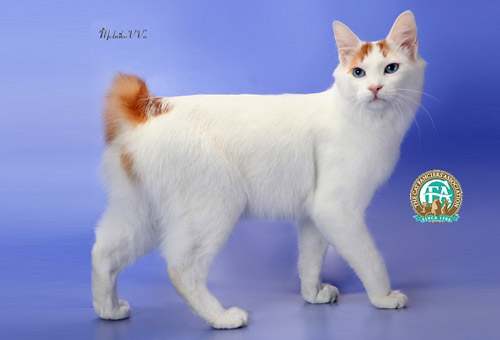


 Pictured: Best of Breed GC, BW, RW WYNDCHYMES WORTH WAITING FOR, Red & White Shorthair Japanese Bobtail Male Photo: © From written records it seems certain that the domestic cat first arrived in Japan from China or Korea at least one thousand years ago. The Japanese Bobtail breed has certainly existed in Japan for many centuries; it is featured in many ancient prints and paintings.
In 1968 the late Elizabeth Freret imported the first three Japanese Bobtails to the United States from Japan. In 1971 they were given provisional status in The Cat Fanciers’ Association (CFA) and were accepted for championship competition in 1976. In 1993 the longhair Japanese Bobtail was accepted by CFA for championship competition. Mrs. Betty O’Brien, who judged the first CFA show in Japan in 1968, was deeply impressed by a longhaired mi-ke owned by Mrs. Kiyoko Tanaka which was exhibited at the show. The longhair Japanese Bobtail has existed for centuries in the orient as have the shorthairs. A large painting from the 15th century hangs in the Freer Gallery of Art in the Smithsonian Institute in Washington DC, showing two lovely longhaired Japanese Bobtails. Their coats are parted neatly down the back and their tails are large and plumey. The longhair Japanese Bobtail exhibits all the same characteristics as the shorthair Bobtail.  Pictured: Second Best of Breed GC, DW SONGGWANGSA LOTUS OF WINTERGARDEN, Blue-Eyed White Shorthair Japanese Bobtail Female Photo: © Melnika V Va Japanese Bobtails are strong and healthy cats. They usually have litters of three to four kittens that are extremely large for newborns. Compared to other breeds, they are active earlier, walk earlier and start getting into trouble earlier. This breed has a low kitten mortality rate and high disease resistance. Kittens are never born tailless, nor are they born with full tails. They are active, intelligent, talkative cats. Their soft voices are capable of nearly a whole scale of tones; some people say they sing. Since they adore human companionship they almost always speak when spoken to.
They like to carry things in their mouths, and most enjoy a good game of fetch. Masters of the pounce, these cats love to ride on shoulders. They are good travelers. They don’t panic at shows or strange hotel rooms, they adjust to dogs and other animals, and are especially good with children. The Japanese Bobtail is a natural breed and does indeed come from Japan; all CFA registered cats can be traced back to the original imports. Any color except the Siamese pattern or Abyssinian type agouti is permitted, the most popular colors are the mi-ke and those colors that can be used to create it: white, black, red, black and white, red and white, and tortoiseshell. Vividly contrasting colors and bold dramatic markings are preferred on the bi-colors. The tail is unique not only to the breed, but to each individual cat. Like our finger prints, no two tails are ever alike. The tail must be clearly visible and is composed of one or more curves, angles, or kinks or any combination thereof. The furthest extension of the tail bone from the body should be no longer than three inches. The direction in which the tail is carried is not important. The tail may be flexible or rigid and should be of a size and shape that harmonizes with the rest of the cat. The genetic factor which created the Japanese Bobtail is completely different from the Manx, a naturally tailless cat. Unlike the Manx, it is due to recessive genes and breeds true. The two breeds are not related in any way. Not only are their tails different, but the body types are completely opposite.  Pictured: Third Best of Breed GC, RW WYNDCHYMES KAELAN OF ANGELBEAR, Cream & White Shorthair Japanese Bobtail Male Photo: © Chanan Pricing on Japanese Bobtails usually depends on type, applicable markings and bloodlines distinguished by Grand Champion (GC), National Regional winning parentage (NW or RW) or of Distinguished Merit parentage (DM). The DM title is achieved by the dam (mother) having produced five CFA grand champion/premier (alter) or DM offspring, or sire (father) having produced fifteen CFA grand champion/premier or DM offspring. Usually breeders make kittens available between twelve and sixteen weeks of age. After twelve weeks, kittens have had their basic inoculations and developed the physical and social stability needed for a new environment, showing, or being transported by air. Keeping such a rare treasure indoors, neutering or spaying and providing acceptable surfaces (e.g. scratching posts) for the natural behavior of scratching (CFA disapproves of declawing or tendonectomy surgery) are essential elements for maintaining a healthy, long and joyful life. There are CFA clubs devoted to the promotion, protection and preservation of the Japanese Bobtail breed. For more information, please send inquiries to CFA at cfa@cfa.org. Text: Dee Hinkle Last Updated: Sunday, July 04, 2010
|
|||||